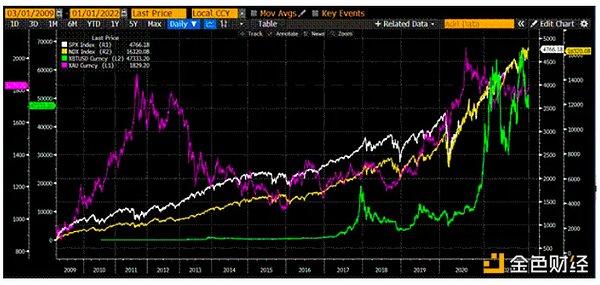At the weekend of last week, everyone was attracted by the Silicon Valley Bank incident, but the Bitcoin NFT community seemed to be in another encrypted world, sharing photos and videos of themselves wearing wizard costumes taking a bath, enthusiastically playing community games, and This meme of wearing a wizard costume and taking a shower is all from a whitelists quest in the Taproot Wizard community.
Taproot Wizard officially shared the mental journey of founder Udi Wertheimer on social media: "On the day of the bankruptcy of Silicon Valley Bank and the panic of USDC , I decided to launch the Taproot Wizard NFT project today and let people record videos of themselves bathing in wizard costumes" . It is reported that Taproot Wizard is an NFT project created on the Bitcoin chain, initiated by encrypted asset developer Udi Wertheimer, to commemorate the Taproot upgrade of Bitcoin and a classic image of the Bitcoin community-Bitcoin Wizard.
Wizard: Bitcoin native meme NFT
The image of Taproot Wizard is a bald wizard wearing a purple robe and holding a magic wand, with eye-catching hand-painted art. Taproot Wizard deliberately designed NFT like this, just to pay tribute to the classic stalk of the Bitcoin community-Bitcoin Wizard.

The bitcoin wizard image first emerged in February 2013, when /r/Bitcoin administrators theymos asked for ideas for community ads. But 1 hour later, a friend named /u/mavensbot submitted this work called "Magic Internet Money Wizard". The creative painting style, eye-catching picture design, and simple and direct cultural slogan quickly became the most popular answer in the forum.
Later, this image was selected as the official promotional image for the /r/Bitcoin forum, and it was posted on Reddit for a while. The simple brainwashing design brought a lot of traffic to the /r/Bitcoin forum, and more and more people clicked in, wanting to see what this "advertisement that doesn't look like an advertisement" really wants to express and represent. Therefore, many people know, understand, buy, and spread Bitcoin. It is worth mentioning that: Bitcoin at that time was only $287.

Seems to be credited with this publicity, 29 Nov 2013. The /r/Bitcoin forum has about 74,000 subscribers, an increase of 36%. At the same time, Bitcoin hit a ATH at a price of "$1132", which once broke the circle and attracted attention.
As a result, the image quickly became an iconic symbol in the Bitcoin community, representing the mystery and allure of Bitcoin. Taproot Wizard is an NFT created by adding elements related to Taproot upgrades based on this image.
In addition, it is interesting that in addition to Taproot Wizards, a Bitcoin NFT project called Bitcoin Wizard was also created to commemorate Bitcoin Wizards. The project of Bitcoin Wizard was released by the author of "Magic Internet Money Wizard". Although it appeared later than taproot wizard, it has already been released.
At present, the two communities have also reached a friendly cooperation. Bitcoin Wizard officials randomly selected 100 people from the holders to AirDrop GOLDEN TICKET, which can obtain the whitelists of Taproot Wizards. The current transaction price is above 0.25 BTC .
The reason why many people in the community support Taproot Wizard is that this meme has an inseparable relationship with the rise of Bitcoin, and it is the most original and purest meme of Bitcoin. In addition to commemorating the classic image of the wizard in the Bitcoin community, Taproot Wizard also believes that the Taproot upgrade of Bitcoin is of great significance to Bitcoin NFT, so it also added the word Taproot to its project name.
What the Taproot Upgrade Means for Bitcoin NFTs
The Taproot upgrade is a major update to Bitcoin aimed at improving the privacy and efficiency of the Bitcoin network. Taproot is the first update to Bitcoin in four years since Segregated Witness (SegWit) went live in 2017. It was first proposed by Bitcoin core developer Gregory Maxwell in January 2018, and it was widely accepted on June 12, 2021. Widespread support from Bitcoin miners and consensus implementation culminated in activation at block 709,632 on November 14, 2021.
The Taproot update contains three Bitcoin Improvement Proposals (BIPs), including BIP 340 (BIP – Schnorr), BIP 341 (BIP – Taproot), and BIP 342 (BIP – Tapscript).
BIP-Schnorr introduces "Schnorr Signatures", a faster, more secure and less data-intensive way to authorize transactions. BIP - Schnorr also enables BIP - Taproot, which uses a technique called "MAST" to submit less smart contract transaction data to the blockchain, while also masking some private transaction information. Finally, BIP – Tapscript equips Bitcoin with an upgraded transactional programming language that utilizes Schnorr and Taproot technologies. Tapscript also allows developers to implement future Bitcoin upgrades more efficiently.
Simply put, the Taproot upgrade introduces Schnorr signatures, which allow multi-signature transactions or transactions involving multiple addresses to look like a normal single transaction. Multi-signature transactions are often used to enable functions such as smart contracts. Before the introduction of Taproot, the data that could be written in a single Bitcoin transaction was limited to 80 bytes. The Taproot upgrade increases the amount of data a transaction can write, from 80 bytes to a full block (approximately 4 MB). It is also because of the Taproot upgrade that it becomes easier to publish a large amount of data to the Bitcoin blockchain, making Bitcoin NFT possible.
The NFT storm of nearly 4 MB in size was once accused of attacking Bitcoin
The founder of Taproot Wizards, Udi Wertheimer, used to be a Web3 developer on the blog Buterin.org to help crypto newbies better understand blockchain technology and Ethereum, so the people who paid attention to Taproot Wizards before were more fans of Udi Wertheimer, not Too many people noticed this project.
Until Udi Wertheimer purposefully orchestrated the largest block and transaction in Bitcoin history, making Taproot Wizards dubbed "the largest Bitcoin block ever".
Bitcoin mining firm Luxor said it mined the largest Bitcoin block ever on Feb. 1, with a block size of 3.96 MB, just shy of Bitcoin's 4 MB limit. The block contains an NFT based on the original “magic internet money” meme called Taproot Wizards.
Taproot Wizard also posted on social media, thanking the full node operators for their support in completing the 3.96 MB sized NFT on-chain, and said: "We made history last night. Even though there are gatekeepers trying to censor us, but We still mined the largest block and largest transaction in Bitcoin history!"

This incident caused a great shock in the Bitcoin ecosystem. Blockstream CEO Adam Back, Bitcoin Core developer Luke Dashjr and others objected to this, believing that this would cause the size of the Bitcoin blockchain to expand rapidly, and the equipment requirements for running a full node would increase significantly. As a result, the number of nodes in the entire network decreases and the resistance to censorship decreases. At the same time, unexpected huge transactions and huge blocks will impact ecological facilities such as wallets , mining pools, and browsers, causing abnormalities in some facilities, such as certain transactions that cannot be parsed normally. In addition, in order to reduce the time for synchronizing and verifying huge transactions and blocks, mining pools or miners may choose not to download and generate blocks without verifying the transactions and blocks, which brings security risks.
They even severely criticized Taproot Wizard for this behavior, saying: "This is an attack on Bitcoin. The Bitcoin block has a 1M limit. Taproot Wizard's 4M data is put on the chain in the witness, and the blocks and transactions are all around. After the 1 M limit, 4 M is fine, and 400 M is fine! In this sense, this is not an innovation, but an attack on a vulnerability!"
What does Taproot Wizard want to express?
There has been a debate in the Bitcoin community: Are there any legitimate uses for NFTs on the Bitcoin blockchain? Or should they be considered spam and discouraged and eliminated?
Many people believe that technical conservatism is a feature of Bitcoin. If iteration breaks extreme stability, its disruption to the protocol may outweigh the marginal benefit of the new innovation. Conservation is part of the immune system. As seen in the scaling wars in 2017, the Bitcoin community has faced significant challenges in scaling its capabilities. At that time, Bitcoin Core rejected the hard fork to expand the block limit, and chose to use SegWit to get the verification information out of the block under the premise of avoiding the Hard fork, thereby bypassing the 1 M block limit. Achieve partial expansion. However, at the time there was no limit to the length of the verification message, which leads to difficult choices today.
Some people think that the choice of the Bitcoin community is likely to do nothing, allowing various applications to enter the Bitcoin blockchain in this way, even if the restriction on OP_RETURN and the expansion debate lost meaning. The Bitcoin ecology is already very large, and it is very difficult to stabilize the Hard fork. However, through Ordinals technology, Bitcoin can achieve more functions without the need for Hard fork, of which NFT is just one of them.
Driven by the belief that Bitcoin has largely lost steam following the success of Ethereum's NFTs, Udi Wertheimer said he would love to see the unique, creative, and humorous culture once established by early cryptocurrency adopters return to the Bitcoin blockchain.
Through Taproot Wizard, what Udi Wertheimer wants to express is: Bitcoin should not only be used for simple transactions, but also can achieve more functions through technological upgrades, and NFT is just one of them. Inspire a new wave of interest and innovation in Bitcoin through disruption, community building, and rebuilding of BTC 's long-standing rebellious spirit. To do this, Udi Wertheimer argues that Bitcoin minimalists need to let go of their ego and prejudices and accept that the blockchain can be used for more than simple transactions.
Until now, many people think that it is impossible to generate a 3.96 MB NFT in the Bitcoin block, but it turns out that through Ordinals and Taproot technology, Bitcoin can achieve more functions, and does not require Hard fork upgrade. Although there are still some controversies in the Bitcoin community, many people still believe that Bitcoin NFT provides an application scenario for the use of Taproot technology and opens up more possibilities for the future of Bitcoin.







